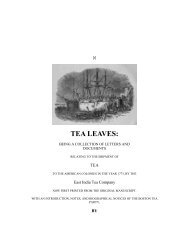Modern magic lanterns; a guide to the ... - Yesterday Image
Modern magic lanterns; a guide to the ... - Yesterday Image
Modern magic lanterns; a guide to the ... - Yesterday Image
- No tags were found...
You also want an ePaper? Increase the reach of your titles
YUMPU automatically turns print PDFs into web optimized ePapers that Google loves.
90 MODEEN MAGIO LANTEBNB.appertaining <strong>to</strong> a lantern by some long Greek name, are oftencalled Aphengescopes. It is a useful device occasionally fordemonstration purposes, but owing <strong>to</strong> <strong>the</strong> very great lossof light, can only be employed with limelight or with <strong>the</strong>electric arc, and <strong>the</strong>n is never Very satisfac<strong>to</strong>ry. In Fig. 65<strong>the</strong> source of light is shown at b, and <strong>the</strong> condensers atCO, <strong>the</strong> object, which is placed at d, having its imagufocussed upon <strong>the</strong> screen by means of <strong>the</strong> objective, e.There is no need <strong>to</strong> get a special lantern for <strong>the</strong> purpose,as a box is easily arranged <strong>to</strong> cEtrry <strong>the</strong> objective at one endand <strong>to</strong> receive <strong>the</strong> nozzle of <strong>the</strong> lantern in <strong>the</strong> directionshown. Such a box should have its interior lined with blackpaper, or better, with black velvet. The back can be arranged<strong>to</strong> carry <strong>the</strong> objects it is desired <strong>to</strong> exhibit, accessbeing obtained by <strong>the</strong> side a, which is closed with a curtain.When <strong>the</strong> Aphengescope i,s being used, and, indeed, in alarge number of o<strong>the</strong>r cases, it will be found that, unlesssteps are taken <strong>to</strong> prevent it, harm will very frequently occurfrom delicate instruments or inflammable substances beingexposed <strong>to</strong> <strong>the</strong> intense heat concentrated upon <strong>the</strong>m by <strong>the</strong>condenser. To obviate this, what is known as an alum cellis employed. This is an arrangement similar <strong>to</strong> that shownin Fig. 61 ; in fact, <strong>the</strong> same cell can be employed forei<strong>the</strong>r purpose, as required. It is filled with a cold saturatedsolution of alum, which must have been carelully filtered soas <strong>to</strong> be quite free from dust or o<strong>the</strong>r floating particles. Thesolution will in course of time get fairly hot, but while allowingnearly all <strong>the</strong> light <strong>to</strong> pass, it will absorb <strong>the</strong> heat, whichwould o<strong>the</strong>rwise be doing harm. In <strong>the</strong> absence of <strong>the</strong> alumsolution, plain water can be employed. It is not quite sobut is satisfac<strong>to</strong>ry enough for most purposes.efficient,Ano<strong>the</strong>r arrangement of <strong>the</strong> lantern for demonstrationpurposes is that shown diagrammatically in Fig. 66, asemployed for vertical projections, as <strong>the</strong>y are called. Thebeam of light from a, as it leaves <strong>the</strong> condenser, b, fallsupon a mirror, fp, placed at an angle of 45 degreeswith <strong>the</strong> horizontal, from which it is reflected verticallyupwards. The table, d d, upon which <strong>the</strong> object <strong>to</strong> beprojected is placed, is immediately over <strong>the</strong> mirror, whileabove it is placed <strong>the</strong> objective, e, bearing above it again a





